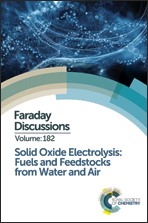Kinetics of CO/CO2 and H2/H2O reactions at Ni-based and ceria-based solid-oxide-cell electrodes
Abstract
The solid oxide electrochemical cell (SOC) is an energy conversion technology that can be operated reversibly, to efficiently convert chemical fuels to electricity (fuel cell mode) as well as to store electricity as chemical fuels (electrolysis mode). The SOC fuel-electrode carries out the electrochemical reactions CO2 + 2e− ↔ CO + O2− and H2O + 2e− ↔ H2 + O2−, for which the electrocatalytic activities of different electrodes differ considerably. The relative activities in CO/CO2 and H2/H2O and the nature of the differences are not well studied, even for the most common fuel-electrode material, a composite of nickel and yttria/scandia stabilized zirconia (Ni–SZ). Ni–SZ is known to be more active for H2/H2O than for CO/CO2 reactions, but the reported relative activity varies widely. Here we compare AC impedance and DC current–overpotential data measured in the two gas environments for several different electrodes comprised of Ni–SZ, Gd-doped CeO2 (CGO), and CGO nanoparticles coating Nb-doped SrTiO3 backbones (CGOn/STN). 2D model and 3D porous electrode geometries are employed to investigate the influence of microstructure, gas diffusion and impurities.
Comparing model and porous Ni–SZ electrodes, the ratio of electrode polarization resistance in CO/CO2vs. H2/H2O decreases from 33 to 2. Experiments and modelling suggest that the ratio decreases due to a lower concentration of impurities blocking the three phase boundary and due to the nature of the reaction zone extension into the porous electrode thickness. Besides showing higher activity for H2/H2O reactions than CO/CO2 reactions, the Ni/SZ interface is more active for oxidation than reduction. On the other hand, we find the opposite behaviour in both cases for CGOn/STN model electrodes, reporting for the first time a higher electrocatalytic activity of CGO nanoparticles for CO/CO2 than for H2/H2O reactions in the absence of gas diffusion limitations. We propose that enhanced surface reduction at the CGOn/gas two phase boundary in CO/CO2 and in cathodic polarization can explain why the highest reaction rate is obtained for CO2 electrolysis. Large differences observed between model electrode kinetics and porous electrode kinetics are discussed.
- This article is part of the themed collection: Solid Oxide Electrolysis: Fuels and Feedstocks from Water and Air

 Please wait while we load your content...
Please wait while we load your content...